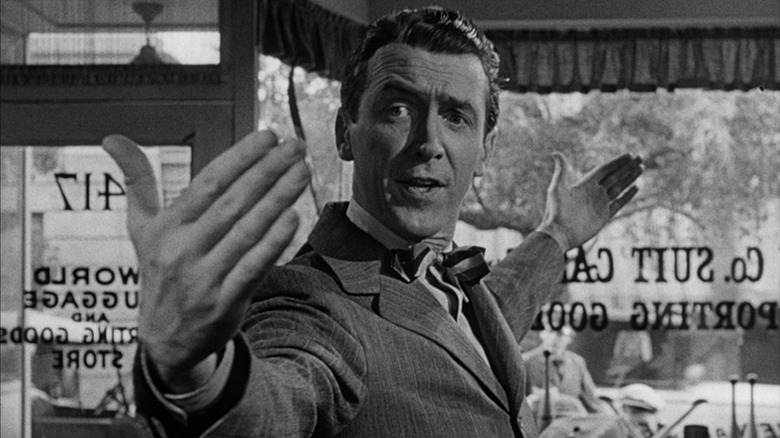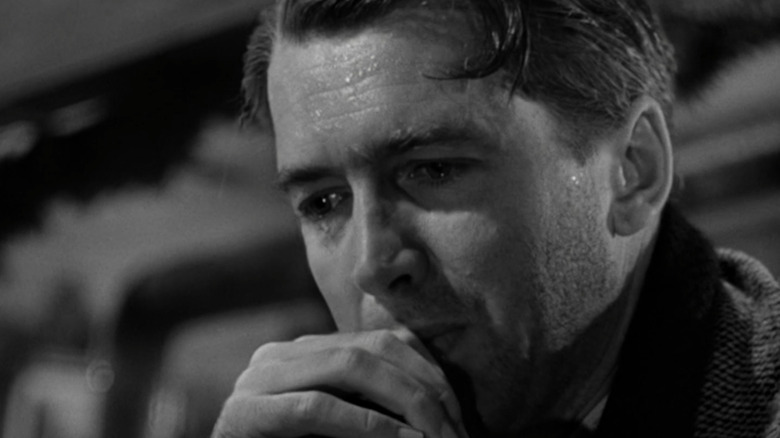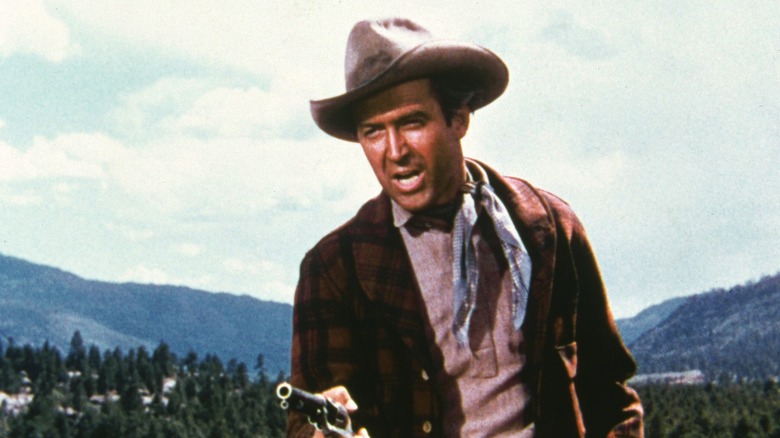James Stewart Wasn't The Same Actor After World War II
Chances are strong that if you think about James Stewart, the image in your mind probably goes to a man built of earnestness. A good natured, wide-eyed innocent who stands as a beacon for his community, probably getting the girl in the end too. This was a well-earned reputation for Stewart, having starred in classics like "You Can't Take It with You," "The Shop Around the Corner," and, most importantly, "Mr. Smith Goes to Washington." His lovable folksy demeanor made him a major star in Hollywood's golden age.
While that may be your first image of James Stewart, I would hope that it is not your only image of him. Those characters do leave an indelible mark on you, but they were far from the only thing Stewart could do on screen. Movie stars often are not properly remembered or recognized for their acting ability but rather the screen persona that made them famous. James Stewart, while he was a movie star, was a true actor, and a damn good one at that.
He had the ability to tap into some true darkness, plumbing the depths of depression, obsession, and anxiety, just as well as some of our most revered actors. Early on in his career, when he was firmly in his "all shucks" mode, this might have felt inauthentic or, at worst, ridiculous. If James Stewart gets highly emotional in a film, it's because he is trying with all of his might to do good. Would people believe he was truly struggling, and would he even believe it himself? That being said, one major thing occurred in Stewart's life that helped him channel all of those other parts of himself and have us believe it, and that was his time serving in World War II.
Recalling the pain of war
In 1941, James Stewart became the first major actor in Hollywood to enlist in the military when the United States had entered World War II. He joined the Air Force and stayed out of the spotlight for five years. It wouldn't be until 1946 that he returned to Hollywood to collaborate with his "Mr. Smith Goes to Washington" director Frank Capra, who had joined the Army and documented the war for the "Why We Fight" propaganda film series, to make what we now see as a Christmas classic in "It's a Wonderful Life."
Stewart's George Bailey is pushed to the brink of suicide. Pressure comes at him from every corner — familial, economic, duty, and psychological — making him wish he had never been born. To play that part, James Stewart really had to look deep inside to find the parts of himself to connect to those emotions. The horrors of war, no matter how righteous you think it is, will stay with the combatants, informing the rest of their lives. Bravely, he allowed himself to tap into that trauma and pain for his performance, most notably in the scene where he makes one last plea to god. Stewart told Guideposts back in 1987 of that scene:
"As I said those words, I felt the loneliness, the hopelessness of people who had nowhere to turn, and my eyes filled with tears. I broke down sobbing. This was not planned at all ... Frank, who loved spontaneity in his films, was ecstatic. He wanted a close-up of me saying that prayer, but was sensitive enough to know that my breaking down was real and that repeating it in another take was unlikely."
Though not a hit, the film pointed in the direction Stewart was headed as an actor, ready to explore his darker sides.
The perfect collaborator in Hitchcock
Though James Stewart would occasionally dabble in his good natured persona from time to time, like in the film "Harvey," much of his best work would be in stripping away that kindly demeanor to explore the depths of his emotions, even his more sinister side. Nobody got this out of him better than Alfred Hitchcock, with whom he made four films over the course of 10 years.
This excavation culminated in Hitchcock's masterpiece "Vertigo," where the kindly James Stewart we see in the opening scenes of the film transforms into a vindictive, controlling maniac who ends up getting a woman killed. "Vertigo" may be looked at as a Hitchcock picture first and foremost, but that film doesn't work without James Stewart wanting to play in those incredibly murky, dark spaces.
Stewart with a harder edge
Other directors, most notably Anthony Mann (who made eight pictures with Stewart), also knew how to tap into the actor's newfound intensity. The best example is probably "The Naked Spur," which sees Stewart as a rough and tumble frontiersman, someone beaten down by life who holds a lot of anger inside, looking to capitalize on a $5,000 reward by any means necessary. Here, and in so many other films, Stewart was given ample opportunity to strip away what we thought of him as an actor and show us sides we didn't think were there.
Acting nowadays is so concerned with naturalism. James Stewart was not a naturalistic actor, but he was a truthful one. Any emotion he tapped into came from an honest place. Looking to his emotional experiences from war served his work beautifully, even if it was maybe painful for him. We may all think of him as the golden retriever of Hollywood's Golden Age, but he was also a phenomenal, emotionally unafraid actor.



